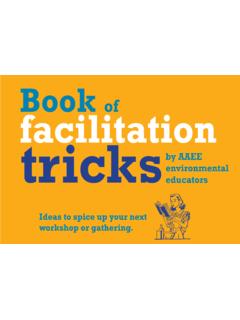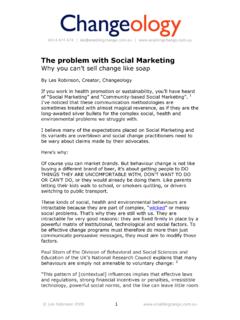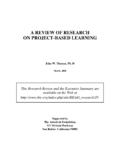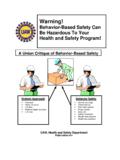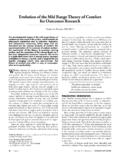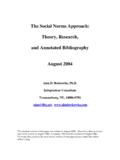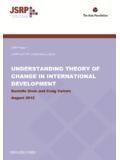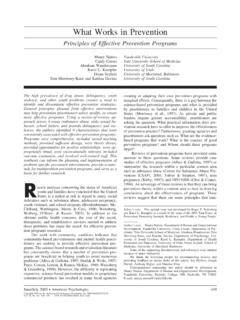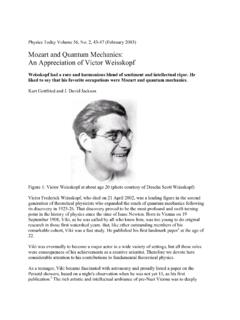Transcription of Changeology An all-purpose theory of behaviour …
1 Les Robinson | 0414 674 676 | 1 Changeology An all-purpose theory of behaviour change All theories are wrong Someone once said: All theories are wrong but some are useful. That s worth keeping in mind when we think about the role of theory in a change program. I doubt there is any field of science more fantastically fragmented than behavioural science, with hundreds of theories competing for attention, most of them occupying mutually self-referential Nevertheless theory is popular. In health promotion, for instance, it s generally held that a behavioural program should be based on a theory . So you ll typically read This program was based on the Transtheoretical Model or This program was based on Social Learning theory or similar statements.
2 Although this approach is probably better than basing a program on no theory , it s problematic for three reasons. Firstly, each theory only describes a fragment of the human experience. Even the many incarnations of costs and benefits or barriers and drivers theories, which seem so self-evident, are not so. For instance, what if people change simply because other people in their network change, or because they always wanted to be like that, or because a powerful role model asks them to change, or other reasons that haven t got much to do with a rational balancing of costs and benefits? Rational exchange theories don t cover those situations. Secondly, picking and choosing theories to suit your assumptions smacks of rationalisation.
3 2 Thirdly, all theories are generic and universal. They cannot take into account the unique contexts, needs, abilities, and perceptions of particular groups of people. Therefore it s important to avoid applying generic theories to the design of a change program. Instead it s better to spend time with your potential actors and strategise a unique theory of change that arises from what you learn about them - which is not as difficult as it A unique theory of change should be a simple, testable statement about why you believe your program will succeed in influencing that particular group s behaviour . It will be specific, contextual and may not generalise to other situations. Here s an example: IF nurses at St Joseph s Hospital have access to healthy food in the workplace; AND IF hospital management mandates rest breaks; AND IF there is a quiet place for nurses to take their meals; THEN there will be a reduction in obesity and stress amongst nurses at St Joseph s Hospital.
4 Your program then becomes a test of that theory of change. Starting with a testable theory of change allows you to act as if you believed in the Scientific Method. Remember the Scientific Method? It the system of practice that says the best way to create new knowledge is to propose a theory , test it, and then use the results to construct a better theory . Proposing a theory of change for a program allows you to do that. Having said that, there is nevertheless a role for generic theories. When we design change programs our worst enemy is often our own subconscious assumptions about what might motivate change in other people. We all bring such assumptions to our work. They are simplistic and frequently wrong-headed (like just shout louder theory 3).
5 A background knowledge of good generic theories can 3 make us better change agents who are less at the mercy of our prejudices. As long as we remember not to take them as holy writ, a collection of generic theories can act as a personal insight engine causing us to ask more challenging and interesting questions as we plan our efforts. Changeology a good enough theory Changeology is such a generic theory of change. It works as a checklist of factors to keep in mind when designing a program. It s a guide for what research questions to ask. It s a guide for evaluation. Most importantly, it s a replacement for half-baked unconscious assumptions. It integrates a number of formal theories I ve found particularly useful in understanding what it takes for new practices or products to be adopted by groups of people.
6 Many of these theories imagine humans in their social environment and some imagine humans in their technological and physical environments too, which is what makes them useful. The theories behind Changeology include: Diffusion of Innovations Self-efficacy Social Learning theory Social Influence theory Self-discrepancy theory 4 Self-determination theory Risk Perception theories Integrating these diverse conceptual frameworks wasn t a clean process. A crowbar and superglue were needed to amalgamate some of the ideas. The result is a good enough theory . It s not perfect - no theory can be - and it s too simple to really encompass human nature. But it s a useful lens on the business of change. The theory consists of 5 conditions or factors.
7 The principle is: for sustained adoption of a behaviour or product, all five of the conditions need to be present in the actors lives. The first thing you ll notice is that the theory is not about changing knowledge, beliefs or attitudes. It s very much about enabling relationships between people and modifying technological and social contexts. The five conditions are: 5 1) Desirability answering a want For someone to adopt a new behaviour or product into their lives, they have to want it. That may seem like an obvious statement. But, in fact, it s radical. Human agency is rarely considered important in strategies or discussions about behaviour change. There seems to be an unstated assumption that people can be convinced to act by the persuasiveness of a message or by an environmental nudge.
8 While this may be true for short term changes in behaviour , it can t be true for sustained behaviours where people have to independently reinvest their time and energy to maintain a behaviour or product long into the future. Put simply, sustained behaviour change means people must believe they are getting an outcome that matters for their lives or businesses. And, because they aren t stupid, the behaviour or product has to work. What do people desire? Universal desires that motivate humans include: to live fearlessly, to exercise autonomy, to be respected by peers, to be competent, to be healthy, to raise healthy children, to realise dreams, and to reduce the innumerable hassles, stresses and humiliations of life. The forms these motivations take, however, can vary greatly between sets and settings.
9 A good way to understand desire is that it s driven by frustration. People are motivated to reduce their frustrations, which can be about day-to-day inconveniences ( bicycling to work to avoid traffic), or about deeper personal frustrations that challenge peoples identities ( bicycling to recover lost health or fitness). Desirability: what to do Once you have identified your actors (the people you hope will adopt the new behaviour ), the next step is to spend time getting acquainted with their frustrations. A simple question to ask them is: What are you unhappy about and would like to change? Once you get a handle on their frustrations, stand back and ask yourselves What frustrations could the behaviour or product help reduce?
10 A good idea is to imagine two circles, one containing the actors 6 frustrations, the other containing the agency s needs. Is there an intersection zone? If so, you can create a common outcome that answers the needs of both. As an example, notice how California s anti-drug campaign abandoned the earlier Just don t do it or Talk to your kids approaches and instead opted for Dinner makes the difference . Now the behaviour is simply to have dinner with your kids - a behaviour that answers manifest parent frustrations as well as helping the agency meet it s goal of reducing drug taking. Your change program should wear its desirability on its sleeve. It do this you should have a simple, crisp, inspiring statement of outcomes that positively answers the actors frustrations.



